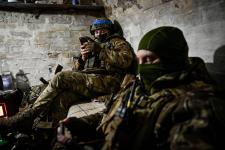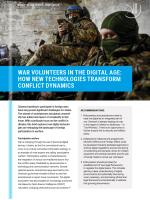War volunteers in the digital age: How new technologies transform conflict dynamics

- Policymakers and practitioners need to treat the digital as an integrated part of war. Denmark is already leading the way in this regard in relation to diplomacy – or ‘TechPlomacy’. There is an opportunity to further expand this to security and military policy.
- Collaborative initiatives and programmes between Defence and Foreign Affairs could be developed including dedicated agencies to enforce digital regulations around monitoring crowdfunding and donation drives for military equipment and combat activities, and the use of social media to recruit war volunteers.
- Policymakers should prioritise the establishment of new legal frameworks to regulate the digital space. This includes gaining a deep understanding of digital environments and potentially intervening when necessary, and promoting ethical and legal frameworks internationally to address this growing phenomenon.
Participative warfare
War is changing through the use of personal digital devices. Ukraine, as the first conventional war to occur in an entirely connected information ecology, is an example of what experts are calling ‘participative warfare’. Participative warfare is characterised by the integration of various non-traditional actors into the conflict space, facilitated by advancements in technology and communication networks. Several national security smartphone apps launched by the Ukrainian government enable civilians to use their smartphones to report troop movements. The digital ecosystem has also enabled an increasingly prominent role played by Open Source Intelligence (OSINT) volunteers, including phenomena such as Ukraine's IT army, which is a globally dispersed online ‘army’ of volunteers who engage in cyber-attacks on Russian assets. By expanding the possibilities of engagement, however, participative warfare is blurring the lines between civilians and combatants, resulting in major gaps in the rules of war and raising concerns about the social and psychological effects of the abundance of graphic war footage easily accessible to smartphone users.
Digital technologies are not only changing how ordinary civilians can participate in war but also how foreign war volunteers travel to support the war in Ukraine, and what they do when they get there. Based on fieldwork in Ukraine, including interviews with volunteers for the International Legion (ILDU), humanitarian staff and officials, as well as private security and military contractors, this brief highlights how digital platforms have become important, outlines some of the emerging challenges that digital devices present and argues for regulation.
Digital pathways to war
The war in Ukraine has been characterised by a high number of volunteers traveling to the country, both in terms of aid volunteers and those traveling to fight. Foreign fighters, for example, use digital tools to organise, fundraise for equipment, and recruit new members. Some of these volunteers already knew each other prior to traveling to Ukraine, but many have sought each other out online, navigating their way to the battlefield through a web of platforms, contacts and online guides.
The sheer number of volunteers that have travelled to Ukraine is partly due to the proximity to other European cities but also the extensive media coverage of the war, as well as the ability to participate directly as an individual through social media. Some participants told me they were initially drawn to the conflict through the endless stream of videos and images of frontline combat they were exposed to on a daily basis online. Platforms like Telegram and Reddit are not just tools for social engagement but also pathways to conflict zones. A search for community is often a key motivation for non-conventional forms of soldiering. The digital realm offers new and powerful ways of forming these communities and leading people to conflict zones. As one security professional in Ukraine remarked, "you would never have made it to Afghanistan because it's not so convenient. Now you've got to come here and be the fucking hero, and have your own little Instagram account, so all your friends can see you."
Digital platforms have made it easier than ever to travel and directly participate in distant wars. Whilst the Ukrainian government attempted to centralise and control the ILDU, and promoted social media campaigns to mobilise recruits, they were resource-stretched, and many prospective recruits sought assistance from other volunteers and citizens from around the world. Several volunteers mentioned the importance of Telegram groups and internet forums like Reddit in helping them make their way to Ukraine and find a unit to join. One American veteran who travelled to fight mentioned being sponsored through the "sponsor a volunteer program" on Reddit and relying on anonymous contacts on Telegram who guided him and facilitated his paperwork. Information and contacts in relation to which units are accepting recruits and are worth joining can also be found through these platforms.
Crowdsourced fundraising and digital logistics
Foreign volunteer units use digital media not only to recruit new members but also to fundraise for equipment, ranging from medical supplies and combat clothing to vehicles and weapons. Logistical support is provided through networks of volunteer groups and charities. Platforms like GoFundMe are now part of the logistics of warfare and are important for supplying kit, weaponry and ammunition. Many of these fundraising campaigns are also framed as humanitarian or charity work but are used for military purposes. This has led to many ILDU units developing their own distinct social media identities, with Instagram and Twitter accounts maintained by the battalions.
This particular use of social media differs from that of the much disparaged "Tik-Tok warriors" who see the conflict as an opportunity for personal prestige. In the social media accounts of most units, faces are usually blurred, with many considering it an unfortunate necessity rather than an ego boost. However, since these units compete for donations, this can sometimes lead to conflicts between groups, which can also play out through damaging online spats, with different units making claims about corrupt practices, demagogic leaders and other issues.
While the commodification of war is not new, these social media-based fundraising methods are changing not only how funds are raised but also how combatants behave on the battlefield. The wealth of drone footage captured on the battlefields of eastern Ukraine is not only valuable for identifying the enemy but can also be edited and selectively shared on social media to raise the profile of specific units and fundraise for more equipment. Indeed, some volunteers lamented that filming and representing war can sometimes become as important as the actual fighting itself.
This is not limited to foreign fighters; Ukrainian brigades also raise funds for their own equipment through social media. Often, they do not involve the Ukrainian Ministry of Defence. Instead, it is officers at the brigade level who directly procure equipment from civil society, volunteer groups and the defence industry. While this decentralised system is highly innovative, it can have downsides. Units that are well-known and have large social media presences can attract the best recruits and equipment, leading to disparities and problems with battlefield coordination. Additionally, there are suggestions that western equipment is prioritised, even if it may not be the most effective on the Ukrainian battlefield, because it is seen as crucial in attracting the best recruits. In this way, how a unit is represented online can occasionally take precedence over its actual battlefield effectiveness.
Demand for technological expertise
The digital realm not only facilitates more people traveling to war zones and becoming involved in fundraising and organisation but also changes the character of the fighters and their roles. While digital technologies are used by military units and prospective volunteers, these technologies also create potential weaknesses. Fighters have been exposed on Telegram groups, and on the frontline, jammers and electronic warfare are part of daily life. Jamming and spoofing tactics are common, as are the extensive use of drones by both sides for reconnaissance and attacks. Technology is seen as a critical factor, and even dating apps like Tinder are considered an operational security issue. An example of this risk is the 13 March 2022 strike on the Yavoriv military base, which was reportedly carried out after the detection of British country code smartphones (+44), indicating the presence of Foreign Legion volunteers. This incident resulted in the deaths of over 30 personnel.[1] Research from Ukraine also suggests that combatants are experiencing war in new ways, and their roles are changing. The growing importance of drones, electronic warfare and secure communication systems has led to an increase in foreign fighters with backgrounds in non-military tech. One computer science graduate with no military experience, volunteering in Ukraine, explained, "if I want to make a career for myself later in the defence sector, where can I learn more than here, right now?"
Prospects for regulation
Digital platforms and connected devices are now essential for various activities, such as traveling to war zones, fundraising for military units and maintaining social relationships. These developments have implications for policymakers involved in supporting war efforts and peacebuilding, as well as those concerned about the domestic consequences of foreign wars.
By addressing these behaviours and implementing targeted regulation, policymakers can mitigate the risks associated with digital participation in modern warfare, enhance security and ensure that digital technologies are used responsibly.
DIIS Experts



